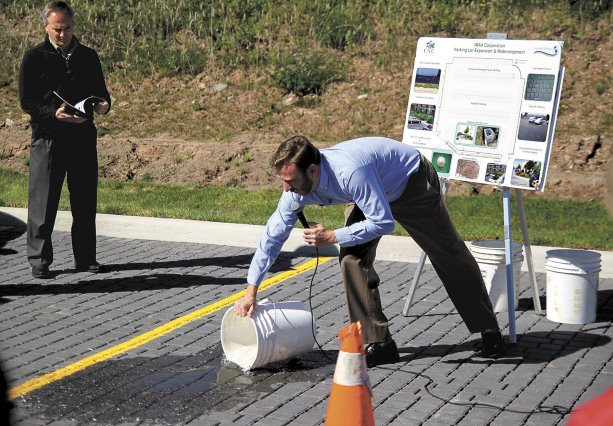A long-term initiative to reduce storm water impact on a local creek, one of the last coastal marshes in the Greater Toronto Area, and ultimately Lake Ontario received a major award earlier this year.
Credit Valley Conservation (CVC) and IMAX Corporation received a Minister’s Award for Environmental Excellence from the Ministry of the Environment and Climate Change for using innovative approaches and technologies in retrofitting the parking lot at IMAX’s Canadian technology headquarters in Mississauga.
"It’s one of the first commercial parking lots in Ontario incorporating a variety of low impact technologies (LID)," says Phil James, the conservation authority’s manager of watershed protection and restoration.
The runoff is collected, absorbed and filtered before entering Sheridan Creek which flows into Rattray Marsh, a provincially significant wetland and "one of the coastal marshes on the Great Lakes and ultimately into Lake Ontario."
Designed by Aquafor Beech and built by Aecon, those innovative features include permeable pavers and three specialized and different stormwater treatment trains incorporating some green and leading edge products.
In one of the trains, for example, runoff from the asphalt parking lot flows into a "Jellyfish Filter" which removes oil and grease before entering into bio-retention units.
Construction was completed in December 2012. However, a five-year monitoring process to measure the performance of the various technologies has been underway since 2013, says James.
The roots of the project actually go back to 2007 when the conservation authority completed a sub-watershed study documenting the impact of sediment and untreated stormwater on Rattray Marsh.
To help highlight the study’s findings, the conservation authority organized a bus tour for a number of stake holders including local companies to highlight the poor condition of the creek.
The tour caught the attention of IMAX officials, especially after the bus stopped at the parking lot where authority staff explained impervious pavement directly channels stormwater into drains.
"IMAX is a forward-thinking multi-national corporation and it is aware of the issues."
Apart from the fact the poorly functioning lot would need reconstruction at some point, the company knew some municipalities have enacted storm water utility charges, which is basically a levy on the amount of untreated stormwater flowing from parking lots, roofs, and other hard surfaces into drains, he points out.
While the approximate $476,000 construction cost was borne by IMAX, the provincial funding helps cover the cost of the monitoring. A number of manufacturers also provided products at a discount, he says.
As the project is intended to monitor and compare the effectiveness of the different retention and filtration technologies, a staged construction schedule was required, says James
After ripping out the asphalt in the back portion of the parking lot, Aecon installed the permeable pavers using two different aggregates. Then the contractor installed the three specialized treatment trains underneath asphalt in the front portion of the 300-space lot.
To cope with the phased construction and the temporary loss of spaces, IMAX implemented a bus shuttle service from nearby parking lots.
"It (the shuttle) was a fairly seamless," says the company’s facilities manager, Lorna Howieson.
"We feel the project is a demonstration of our corporate responsibility and will produce result which can be measured."
At the heart of the project was the company’s willingness to allow conservation authority staff to come on to its property to inspect how the systems are performing, says James.
"We were able to obtain a legal agreement with IMAX which allows the authority to monitor for a five-year period, with the possibility of a renewal. Not every corporation would do that."
Some of the benefits to the company include a better functioning and less-expensive-to maintain parking lot.
Besides the environmental benefits, the project is also spurring the growth of Ontario green jobs through the use and promotion of the specialized stormwater management systems. And that’s the message the conservation authority was to spread, especially with the publicity generated by the Minister’s Award, he says.
"We have a good story to tell."




Recent Comments
comments for this post are closed